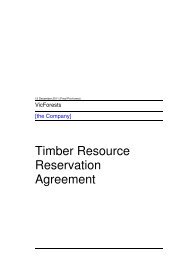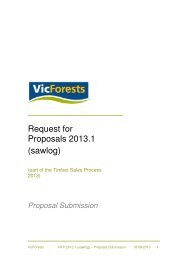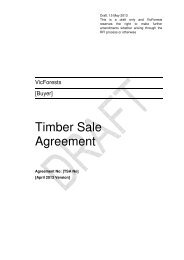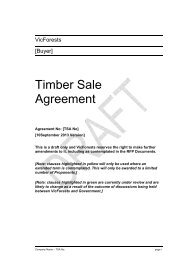Module 5 - VicForests
Module 5 - VicForests
Module 5 - VicForests
Create successful ePaper yourself
Turn your PDF publications into a flip-book with our unique Google optimized e-Paper software.
0 Introduction<br />
Element group (Operational provisions Compliance Element), which had only eight applicable audit<br />
criteria, had all criteria assessed as being in compliance. A large proportion of the criteria in the<br />
Operational Provisions Compliance Element group, such as suspension of operations in wet<br />
conditions, were unable to be assessed due to there being no harvesting current during the audit.<br />
Of the six groups, the Biodiversity Conservation Compliance Element group (Protection of biodiversity<br />
values; Habitat trees; Rainforest; and Forest health Compliance Elements) had the lowest level of<br />
compliance, with around 75 percent of the applicable criteria assessed as compliant. Areas of noncompliance<br />
included systemic weaknesses identified with monitoring and control of noxious weeds. In<br />
general, the areas identified for protection of significant habitat and rainforest had been marked<br />
appropriately and harvesting activities excluded. Notable exceptions to this were machine entry into<br />
two areas of rainforest and their buffers. Both of the rainforest buffers had been identified in Forest<br />
Coupe Plans and maps and harvesting had been excluded, with entry in each case appearing to have<br />
been by an individual bulldozer or excavator, in one case apparently during firebreak construction.<br />
These non-compliances were assessed as having Major EIA risk ratings.<br />
The River Health, Water Quality and Soil Assessment Compliance Element group (River Health,<br />
Water Quality and Soil Assessment; Waterways; Buffers; Filters; Slopes; Camp maintenance, fuel<br />
storage and waste disposal; and Water catchments Compliance Elements) addressed classification<br />
and exclusion of waterways from harvesting activities, slope and special water catchment restrictions,<br />
and management of in-coupe machinery maintenance areas. The Compliance Element group was<br />
assessed as having been managed appropriately, with a small number of non-compliances identified,<br />
including failure to classify streams adjacent to three coupes, machinery or harvest debris entering<br />
filters on four coupes and instances of litter on coupes.<br />
The Roading Compliance Element group (Road planning; Road design; Road construction; Road<br />
maintenance; Suspension of cartage; and Road closure Compliance Elements) addressed the<br />
planning, construction and temporary and permanent closure of roads used during timber harvesting.<br />
In the majority of cases, roads were assessed as planned and designed to minimise impacts, with<br />
some deficiencies identified, mainly on steeper slopes. Management of stockpiled soil was also<br />
assessed on several coupes as being non-compliant, in one case resulting in a Moderate EIA risk<br />
rating due to its location within a rainforest buffer. Retaining access to roads that are no longer<br />
needed was also identified as non-compliant in several instances for both <strong>VicForests</strong>- and DSEmanaged<br />
roads.<br />
The Coupe Infrastructure Compliance Element group (Coupe infrastructure – general; Log landings<br />
and dumps; Snig and forwarding tracks; and Boundary tracks Compliance Elements) addressed<br />
landings, snig tracks and boundary tracks. Infrastructure was assessed as being generally minimised<br />
and rehabilitated appropriately. Issues identified included inadequate respreading of topsoil on some<br />
landings, retention of excess bark around some landings due to reduced regeneration burning, and<br />
inadequate drainage of sections of snig tracks and boundary tracks, mainly on steeper slopes in the<br />
case of boundary tracks.<br />
No non-compliances with Severe EIA risk ratings were identified in any coupes during the audit.<br />
Two non-compliances with an EIA risk rating of Major were identified, both resulting from machine<br />
entry into rainforest buffers and associated rainforest.<br />
Thirty-one non-compliances with Moderate EIA risk ratings and 28 non-compliances with Minor EIA<br />
risk ratings were also identified, mainly in the following areas:<br />
xii 42807504/01/01











